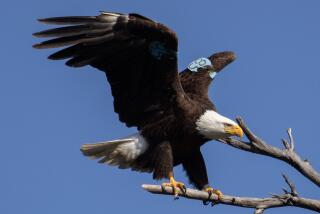BREEDING BIRD: COMMON YELLOWTHROAT (Geothlypis trichas)
- Share via
Description: Adult males have broad black mask bordered above by white and below by a bright yellow throat and breast; undertail coverts are yellow and underparts are dark olive. Female’s crown, back, wings and face are olive colored with a whitish eye ring.
Habitat: Overgrown fields, fresh and salt water marshes.
Diet: Insects and seeds.
Displays: Male follows female while swooping from perch to perch, performing calls and a garbled song.
Nest: Made of loosely-woven weeds, grass, bark and ferns. Lined with finer materials.
Eggs: White to creamy, marked with brown and black.
Song and Call: A loud wichity wichity wich. Call is a raspy chuck sound.
Breeding bird atlas: To report bird breeding activity in your neighborhood, or to get information on the breeding bird atlas, call Sea and Sage Audubon Society members Sylvia Gallagher, (714) 962-8990, or Nancy Kenyon, (714) 786-3160.
Note: Map is divided into 5-kilometer squares so that Audubon Society volunteers can more easily survey areas on a regular basis.
Fireside Books (1988); “Field Guide to the Birds of North America,” National Geographic Society (1987); “Birds of Southern California: Status and Distribution,” Garrett and Dunn, Los Angeles Audubon Society (1981).
Indicates 5-kilometer-square areas where breeding activity has been confirmed.
Note: Map is divided into 5-kilometer squares so the Audubon Society volunteers can more easily survey areas on a regular basis.
Sources: Sea amd Sage Audubon Society; “The Birder’s Handbook,” Ehrlich, Dobkin & Wheye, Fireside Books (1988); “Field Guide to the Birds of North America,” National Geographic Society (1987); “Birds of Southern California: Status and Distribution,” Garrett & Dunn, Los Angeles Audubon Society (1981).
More to Read
Sign up for The Wild
We’ll help you find the best places to hike, bike and run, as well as the perfect silent spots for meditation and yoga.
You may occasionally receive promotional content from the Los Angeles Times.






